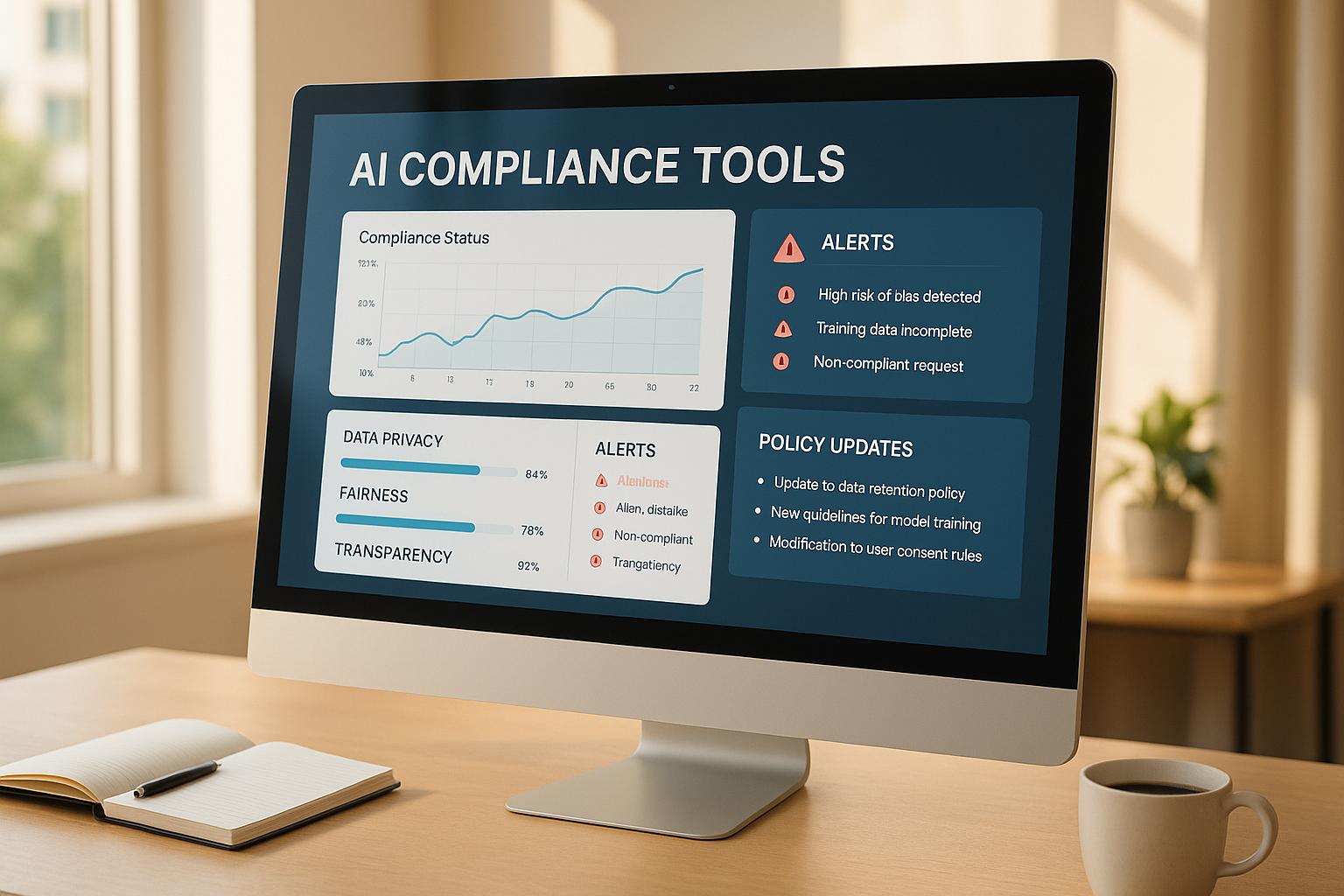Predictive analytics is transforming how businesses plan, forecast, and make decisions. Here’s what you need to know:
- AI is making predictive tools accessible to businesses of all sizes, not just large enterprises.
- Small businesses are leveraging AI for smarter decisions, like Mercado Libre using Stable Diffusion to improve product ads for SMEs in April 2025.
- Key advancements in AI include:
- Automated data analysis for ease of use.
- Real-time insights for faster decision-making.
- Continuous learning models for better accuracy over time.
- Generative AI, real-time systems, and automated tools are reshaping forecasting, planning, and operations.
- Ethical AI practices are becoming a priority, ensuring transparency and fairness in decision-making.
Quick Overview of AI Trends
- Generative AI: Simulates scenarios with synthetic data for better planning.
- Real-Time Analytics: Adjusts strategies instantly based on live data.
- Automated Insights: Simplifies data processing and integrates natural language queries.
- Ethical AI Frameworks: Focuses on transparency and compliance with regulations.
Takeaway: Businesses can improve efficiency, reduce costs, and boost revenue by adopting AI-driven predictive tools tailored to their needs. Start with automated insights, then scale to advanced systems like generative AI or real-time analytics.
Main AI Trends in Predictive Analytics
Generative AI in Forecasting and Planning
Generative AI is changing how businesses approach forecasting and planning. By using synthetic data, companies can simulate various scenarios without using actual resources. This allows them to test strategies and make better decisions while minimizing risks.
"The future of creativity is shaped by our community. From reimagining workflows to building finetunes, creators and builders push the boundaries of what's possible with Stable Diffusion - setting a new standard in media generation." - Stability AI
In addition to long-term forecasting, many businesses are now using real-time analytics to adjust their strategies on the fly.
Real-Time Prediction Systems
Real-time analytics have become critical for businesses that need to react quickly to changing market conditions. These systems process data as it comes in, enabling companies to make decisions based on current trends rather than just historical data. Real-time insights can help businesses:
- Track customer behavior as it happens
- Adjust prices in response to demand
- Identify and resolve potential issues early
- Manage inventory more efficiently
Automated Analysis Tools
AI-powered platforms are simplifying data analysis by automating tasks like data cleaning, insight generation, and workflow updates. These tools provide several benefits:
-
Automated Data Processing
They handle large, complex datasets, identify patterns, and integrate information from multiple sources to give a clear operational picture. -
Natural Language Queries
Modern AI systems let users interact with data using plain English, making it easier for non-technical teams to use advanced analytics. -
Continuous Learning
These platforms improve over time, learning from new data and user interactions to deliver more accurate predictions.
While automation is streamlining processes, businesses are also focusing on making AI systems more transparent and fair.
Prioritizing Transparency and Fairness in AI
As AI becomes a bigger part of decision-making, ensuring transparency and fairness is essential. Companies are working on systems that explain their predictions clearly and comply with U.S. regulations.
| Aspect | Impact |
|---|---|
| Decision Explanation | Provides clear insights |
| Regulatory Compliance | Aligns with U.S. standards |
In April 2025, Stability AI enhanced Stable Diffusion's performance on AMD Radeon™ GPUs and Ryzen™ AI APUs, improving its capabilities on these platforms.
The Top 5 AI And Data Trends 2025
How AI Trends Compare
Explore how AI trends stack up to make smarter investments in predictive analytics. Recent studies and market data highlight the benefits and trade-offs of different AI approaches, offering a clearer path to actionable results.
AI Trends Comparison Chart
Here’s a quick look at some key AI trends based on current market insights:
| Feature | Generative AI | Real-Time Analytics | Automated Insights | Ethical AI Framework |
|---|---|---|---|---|
| Initial Cost | $50,000–$200,000 | $20,000–$80,000 | $1,000–$10,000/month | 15–30% project premium |
| Technical Requirements | High | Moderate | Low | Moderate |
For example, a Florida resort chain saw a 19% jump in revenue in 2024 by using generative AI for demand forecasting alongside real-time pricing tools. Combining AI strategies often leads to better outcomes.
Costs vary depending on business size. Automated insights tools typically pay off within 3–6 months. A Texas-based HVAC company, for instance, used Writesonic’s automated reports to cut customer churn by 22% in just four months. These examples show how AI integration can lead to measurable gains.
- Generative AI requires advanced computing power and skilled professionals.
- Real-time analytics systems depend on strong cloud infrastructure and efficient data streaming.
- Automated insights tools easily integrate with existing business intelligence platforms.
- Ethical AI frameworks need ongoing monitoring and compliance tools to manage regulatory risks.
A Chicago fintech company demonstrated the value of a balanced approach. By combining automated insights with ethical AI audits, they reduced loan approval bias by 34% while maintaining fast processing times.
When choosing AI tools, align them with your business goals. Data from MIT shows that many companies start with automated insights tools before moving into more complex systems like generative AI or real-time analytics.
Cost Per Prediction Breakdown
Understanding the cost per prediction can also guide your decision-making:
- Automated tools: $0.001/query
- Real-time systems: $0.005/query
- Generative AI: $0.01/query
Even small differences in these costs can have a big impact on overall expenses, especially for high-volume use cases.
sbb-itb-bec6a7e
What This Means for U.S. Companies
The rise of AI-driven predictive analytics presents new ways for U.S. businesses to boost efficiency and make smarter decisions. But to fully benefit from these tools, companies need a clear plan to tackle both technological and operational hurdles.
Preparing for AI Tools
Rolling out AI tools successfully starts with thoughtful preparation. Companies that see the best outcomes focus on three main areas:
- Building a solid data infrastructure with secure cloud storage, seamless API connections, and strong security measures.
- Training teams to understand and utilize AI effectively.
- Establishing privacy safeguards and audit systems.
Key steps to get started include:
- Conducting a comprehensive data privacy review.
- Defining clear success metrics.
- Creating detailed timelines for implementation.
- Developing training programs for employees.
- Setting up systems to monitor performance.
Laying this groundwork ensures businesses are ready to take full advantage of AI’s potential.
Improving Operations with AI
Once the basics are in place, businesses can start using AI to improve various aspects of their operations. Thoughtfully implemented AI can bring measurable benefits across different areas.
Here are some proven ways AI is helping businesses:
- Streamlining customer service with automated response tools.
- Strengthening risk management through predictive models.
- Cutting costs with automated workflows.
- Boosting revenue with personalized marketing strategies.
For example, in March 2023, Spotify collaborated with Mailchimp to implement AI-powered email verification. In just 60 days, they achieved:
- A drop in email bounce rates from 12.3% to 2.1%.
- A 34% improvement in email deliverability.
- $2.3 million in additional revenue.
- A successful cleanup of a 45-million-subscriber database.
(Source: Mailchimp Case Studies, 2023)
To get the most out of AI, companies should choose tools that fit their specific needs and capabilities. Platforms like AI for Businesses provide a curated list of AI solutions designed to help small and mid-sized businesses streamline operations and see quicker returns on investment.
Conclusion: What's Next for Predictive Analytics
Predictive analytics is advancing quickly with the help of AI technologies, making sophisticated forecasting tools available to businesses of all sizes - no specialized technical background needed.
Recent applications across various industries highlight how AI tools are reshaping operations and improving decision-making processes.
Key Areas for Business Leaders to Focus On
The future of predictive analytics offers new possibilities but also demands careful planning. To succeed, business leaders should prioritize the following:
Technology Integration
- Use no-code AI platforms for easier adoption.
- Choose tools that offer real-time insights and automation.
- Ensure compatibility with your current systems.
Strategic Implementation
- Maintain high-quality data to ensure accurate predictions.
- Train employees to fully utilize AI tools.
- Set clear metrics to measure success.
Ethical Practices
- Promote transparency in AI-driven decisions.
- Address potential biases in models.
- Strengthen data security measures.
By focusing on these areas, businesses can align technological progress with responsible practices.
The ongoing advancements in predictive analytics aim to deliver practical tools that fuel business growth. Companies that adopt these strategies will be well-positioned to thrive in the digital age.
FAQs
How can small businesses adopt AI-powered predictive analytics tools without needing a large technical team?
Small businesses can successfully implement AI-driven predictive analytics tools by leveraging user-friendly platforms designed for non-technical users. Many modern tools offer intuitive interfaces, pre-built models, and automated workflows that minimize the need for extensive technical expertise.
To get started, focus on tools that provide clear onboarding tutorials, customer support, and customizable templates for specific business needs. Additionally, consider platforms that integrate seamlessly with your existing software to streamline operations. By starting small and scaling as needed, businesses can harness the power of predictive analytics without requiring a dedicated technical team.
What ethical considerations should businesses address when using AI in predictive analytics?
When integrating AI into predictive analytics, businesses should prioritize transparency, fairness, and data privacy. Ensure that AI models are explainable and that stakeholders understand how predictions are generated. Address potential biases in data to avoid unfair outcomes, and comply with data privacy regulations to protect customer information.
Additionally, companies should consider the societal impact of their AI applications, ensuring they are used responsibly and align with ethical standards. Regular audits and updates to AI systems can help maintain accountability and trust.
What are the cost and technical differences between generative AI, real-time analytics, and automated insights in predictive analytics?
The costs and technical requirements of generative AI, real-time analytics, and automated insights can vary significantly based on factors like implementation scale, data complexity, and business needs. Generative AI often requires substantial computing power and specialized infrastructure, which can lead to higher upfront costs. Meanwhile, real-time analytics focuses on processing data instantly, which demands robust systems capable of handling large, continuous data streams efficiently. Automated insights, on the other hand, are generally designed to simplify data interpretation and may have lower technical requirements but still depend on the quality of the underlying data models.
For small and medium-sized enterprises (SMEs) or growing businesses, it's essential to evaluate each technology's value proposition against your specific goals and resources. While generative AI can unlock creative possibilities, real-time analytics and automated insights are often more practical for immediate operational improvements.


